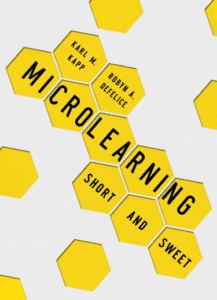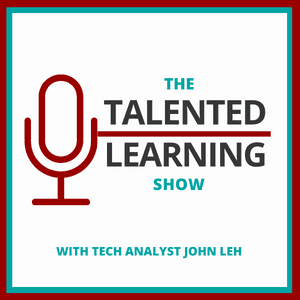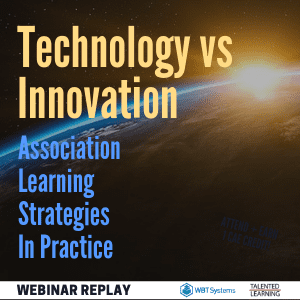
Podcast: Play in new window | Download
Subscribe: Apple Podcasts | Spotify | Amazon Music | Android | iHeartRadio | Blubrry | Email | RSS
EPISODE 27 – TOPIC SUMMARY AND GUEST:
 Microlearning. I hear about it on a daily basis. But when I ask clients to define it their own words, the answers are all over the board.
Microlearning. I hear about it on a daily basis. But when I ask clients to define it their own words, the answers are all over the board.
It’s time for clarity and consensus. That’s why I’m glad that Dr. Karl Kapp and Dr. Robyn Defelice are tackling this topic in their new book, “Microlearning: Short and Sweet.”
Today, I’m fortunate to talk with Karl as part of a virtual book tour that he and Robyn are conducting. If you’re a regular listener, you’ll recall that Karl joined us nearly two years ago to discuss gamification in business applications. That episode is now the most popular interview in our show’s history. And I bet this one will be just as well-received.
KEY TAKEAWAYS:
- Microlearning is a deceptively simple concept. Perhaps that’s why it inspires so many myths and misconceptions.
- Effective microlearning is not just bite-sized content. Successful applications approach microlearning as a process.
- Microlearning and gamification are related in several ways. It’s useful to consider how they can work together to improve learning outcomes.
Q&A HIGHLIGHTS:
Welcome back, Karl! It’s hard to believe that nearly 2 years have gone by since you were on our show for the first time.
Thanks, John. It’s good to be back.
Why did you decide to write this new book about microlearning?
Well, it’s important to recognize that people have less time available for learning. So there’s more interest in learning based on short pieces of information.
Many learning management systems are now mobile-enabled, so we can receive these pieces of information on our phones. But that raises some questions:
- Exactly what kind of information should we send to a phone?
- How often should we send it?
- What’s useful?
Right.
So microlearning is this concept of providing highly targeted information that covers one or two topics in a very short amount of time.
How do you define short?
There’s all kinds of talk about whether it’s 5 minutes or 15 minutes or whatever. We don’t define it by time. We just say short, targeted information that is delivered through your phone or desktop – whatever you prefer.
So if you’re a financial professional, maybe it’s a brief update about three of the latest accounting rule changes. Or if you’re an HR manager, maybe it’s a list of three ways you can be sure your organization is in compliance with overtime guidelines.
Makes sense…
This could be standalone information or how-to content. But “one-and-done” training doesn’t always work, so microlearning may also be integrated into a larger curriculum, where continual reinforcement is very effective.
For example, say you’re a subject matter expert who delivers free webinars. As a follow-up, you can offer monthly updates about each topic to webinar attendees who pay for an annual subscription.
This kind of reinforcement helps people focus and remember information. It also helps change their attitudes or behaviors related to that information.
So microlearning is less about making the content short and sweet – and more about proactively pushing it out and extending it over time?
It’s a little bit of both. There are many ways to classify microlearning, but we define six types. One is to push out content over time. Another is to refresh content over time.
You could also use one of many apps that support microlearning experiences. For example, we talk about a really cool app called Presentr. It’s designed to teach individuals how to give effective presentations.
You download the app and practice speaking. It tracks your pace, volume and other key factors, and recommends ways to improve. We classify this as a “coaching” type of microlearning.
Great idea!
Although there are many types of microlearning, here’s the common ground: It’s an instructional unit that supports brief engagement in an activity that’s intentionally designed to elicit a specific outcome from participants. And we intentionally use the term “participant” rather than “learner.”
Why?
Well, the other day I had to change my bathroom shower head. So I pulled up a 5-minute how-to video on YouTube and followed step-by-step instructions.
Could I tell you those steps if you quizzed me today? Probably not. That video wasn’t designed for me to remember how to change a shower head forever.
But it helped me perform in the moment. And that fits into the microlearning realm.
You’re known as a gamification expert. Do you see overlap between gamification and microlearning?
First, while I’m known for games and gamification for learning, I’ve always been interested in learning in general – which is what got me into games and gamification. I’m deeply interested in the underlying mechanisms of how people gain new information and learn. That was one driver.
Also, I’ve found that most gamification platforms use microlearning to deliver gamified content.
Let’s say you want to level-up to the top level in a gamified learning environment. To accomplish that, you need some kind of learning, training and behavioral change. And that happens through microlearning.
Got it…
But the content isn’t always effective. One vendor told me that their platform works well and everybody likes the gamification experience, but the content that clients create is sometimes off-base, so the learning experience doesn’t jell.
For example clients sometimes:
- Cut a large course into smaller segments without making other adjustments
- Focus on more than one objective
- Create vague content
- Mix multiple learning domains.
So platform providers are frustrated because they may have a great package, but they don’t have great content – and they’re not in control of that content.
Sounds frustrating.
Yes. And it makes a lot of sense. There are so many microlearning vendors that obviously have great technology. But I wonder about the design of a microlearning intervention. Because the rest doesn’t matter if the content isn’t designed effectively.
You can’t just copy and paste from a policies and procedures manual written in Microsoft Word and call that microlearning, right? You need some kind of design behind it.
Yep.
So that got me interested in how to help people design better instruction. How can we help them develop content that’s more meaningful, effective and comfortable for people who use it?
That’s how I got involved in microlearning. There was a big need and people were asking me how to do it.
For better results, should we tie microlearning to a skill and competency model?
It can be independent. But it’s usually most effective when you’re improving skills and competencies. Think of technology sales reps who need to remember product features or key elements of the sales model, itself.
They can listen to a brief audio clip that refreshes their memory when traveling to a sales call or waiting in the lobby. This quick bit of reinforcement helps them practice so they can bring this information to the sales conversation.
Is there a preferred medium for microlearning?
Video is definitely the hottest choice right now, for a variety of reasons. It’s great for conveying emotions. It’s also ideal for showing procedures step-by-step or transporting somebody to a specific location, like a technical environment.
Good point.
Animated explainer videos are also popular because you can share a lot of information in a short timeframe. In addition, podcasts are attractive because they’re relatively inexpensive to produce and they’re easy to edit into a short, focused package.
Text messages are another viable option. For example, an interesting study from India involves men whose glucose intolerance predisposed them to Type 2 diabetes. They participated in a microlearning intervention where they received text messages twice a day. This actually changed their behavior and helped a large proportion of them avoid Type 2 diabetes.
We also talk about infographics and flashcards as methodologies. There are digital flashcards as well as physical flashcards. You could even use a laminated job aid posted in a work cell.
So it doesn’t need to be digital?
Right. Microlearning doesn’t need to be driven by technology to make a difference.
People may think analog content isn’t cool, or you won’t get funding or participants won’t pay attention. But there’s actually a lot of value in analog instructions, job aids and performance assistance. All of these are forms of microlearning.
But video is getting most of the glory these days?
Yes. In part, video may be so attractive because people assume it’s easy. They may think they can simply set-up a camera and record someone talking. But that’s not necessarily effective.
You need to plan what you’ll say. You need to set it up. You need to reinforce it. You need to include on-screen interaction to illustrate what you’re talking about, so people get it. Many elements are involved.
The platform guy in me is wondering – is an LMS the best way to support microlearning?
Good question. With some older learning management systems, delivering small bits of content can be challenging.
It takes more time for people to get into an LMS and find what they need, so content isn’t available. Plus, a lot of content in legacy learning systems is too large or isn’t designed for microlearning consumption.
Of course as you know, there are many different LMS platforms. Some seamlessly support microlearning with no problem. But that’s not the only choice.
Now there are also gamification/microlearning platforms. These solutions have been developed specifically to provide frictionless content access in only one or two clicks.
So, would you recommend a specialized microlearning platform? Is that incremental to an LMS?
Often, gamification/microlearning platforms are separate. Some integrate with the LMS through deep linking or other methodologies. Some can sit right on top of the LMS. So there’s some integration with existing systems.
Okay…
But microlearning platforms often compete directly with the LMS. They usually include many LMS elements and they can be integrated right into your everyday workflow.
For example, imagine you’re a big-ticket retail sales rep. Recently, when completing several financing applications, you forgot to ask customers for their credit history.
Many microlearning platforms will notice that oversight. They’ll send you a message that points to a brief refresher video about when and how to request credit history. Or they’ll reach out with another quick intervention.
Interesting. So is the cost of developing microlearning less than other types of content?
Many people assume the word “micro” means lower cost. And that would be true if you could replace all the instruction in your company with just one piece of microlearning. But it doesn’t work that way.
Sometimes it can even cost a bit more. For instance, say you want to convert a one-hour compliance course to microlearning. You’ll probably need to think carefully about how to reshape each of those 60 minutes of instructional content to work more effectively in a microlearning context.
In other words, you can ramble on in a class or in an elearning module. But if you want to develop concise, high-impact content that changes behavior, you’ll need to give it a lot of thought and effort.
Sure…
However, once you get used to creating microlearning, you become more efficient. You start understanding almost intuitively what needs to be done. So over the long-haul, microlearning development costs may decrease.
That makes sense. So of course, in the extended enterprise world, we love measuring everything. How should we measure microlearning outcomes?…
…FOR COMPLETE ANSWERS TO THIS QUESTION AND MORE, LISTEN TO THE FULL PODCAST NOW!






